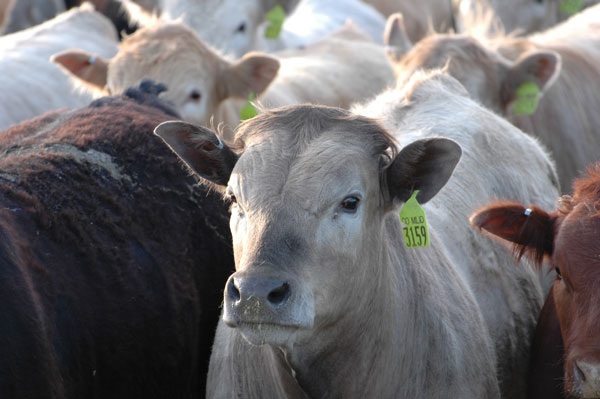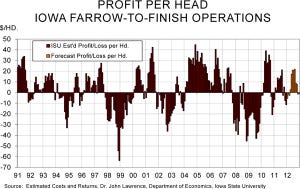U.S. cattle feeding and farrow-to-finish hog production hold similar production positions in their respective species, but their profit prospects for 2012 are very much different.
March 8, 2012

The profit pictures for the cattle feeding and farrow-to-finish pig production sectors for this year could hardly be more different. Cattle feeders – at least when one considers full yardage and feed-markup costs – are looking at severe losses this year, while hog producers are looking at their third profitable year in a row. The chart entitled “Choice steer price vs. breakeven” shows projected breakeven costs through July, courtesy of the Livestock Marketing Information Center. These estimates include full yardage and feed-markup costs; thus, they overstate the cash-cost situation of yard-owned cattle. But they’re still an accurate portrayal of long-run costs and they imply some serious deficits for cattle this summer, especially with the $4-$5 selloff we’ve seen in recent sessions.
The chart entitled “Choice steer price vs. breakeven” shows projected breakeven costs through July, courtesy of the Livestock Marketing Information Center. These estimates include full yardage and feed-markup costs; thus, they overstate the cash-cost situation of yard-owned cattle. But they’re still an accurate portrayal of long-run costs and they imply some serious deficits for cattle this summer, especially with the $4-$5 selloff we’ve seen in recent sessions. Meanwhile, the chart headlined, “Profit per head – Iowa farrow-to-finish operations,” paints a very different picture for hog producers. Continued strength in Lean Hogs futures and moderating costs have left expected returns near $20/head this summer. We say “moderating” costs because they aren’t expected to be significantly lower for the year than they were in 2011. Our estimates, using closing corn and soybean meal futures prices for Tuesday, are for Iowa farrow-to-finish operations to see breakeven costs of $86.06/cwt carcass in 2012. That is just 57¢/cwt. lower than last year.
Meanwhile, the chart headlined, “Profit per head – Iowa farrow-to-finish operations,” paints a very different picture for hog producers. Continued strength in Lean Hogs futures and moderating costs have left expected returns near $20/head this summer. We say “moderating” costs because they aren’t expected to be significantly lower for the year than they were in 2011. Our estimates, using closing corn and soybean meal futures prices for Tuesday, are for Iowa farrow-to-finish operations to see breakeven costs of $86.06/cwt carcass in 2012. That is just 57¢/cwt. lower than last year.
Similar costs and, at least according to Lean Hogs futures prices, slightly higher hog prices should provide profits roughly $2.40/head higher than in 2011. Our current estimate is for average profits of $7.35/head this year.
Why the difference in performance – especially given record-high fed cattle prices? The answer is found in the intermediary feeder cattle market. Cattle feeders buy virtually all of the animals they feed where farrow-to-finish producers simply transfer pigs internally.
The need to buy feeder animals leads to behavior that frequently torpedoes cattle-feeding profits as yards chase feeder cattle to the point of bidding away all profits. That is true in spades this year as feeder-cattle supplies are very tight.
Oklahoma City 600-700-lb. feeder steers topped $170/cwt. the week of Feb. 24 and remained at $169.61 last week. 400-500-lb. steer calves have eclipsed the $200/cwt. mark the past two weeks in Oklahoma City.
Of course, not every hog is produced in a farrow-to-finish enterprise. A substantial number of pigs are traded each week as either weaned pigs (10-14 lbs., roughly 21 days old) or feeder pigs (40-50 lbs., roughly eight weeks old), moving from specialized farrowing operations to feeding operations.
USDA’s Agricultural Marketing Service reported prices for 5.1 million weaned pigs and 1.2 million feeder pigs last year but more (number unknown) were traded through private treaty and not reported to USDA. A good portion of these pigs are formula priced on spot markets or on deferred Lean Hogs futures with current or deferred corn and soybean meal prices frequently factored in as well.
But the spot-traded pigs are subject to the same forces as feeder cattle. Weaned-pig prices have been near-record high in recent weeks, driven by expected summer profits and, to some degree, death losses related to porcine reproductive and respiratory syndrome (PRRS). These losses have been large this year but whether they are greater than in years past remains to be seen.
You May Also Like



